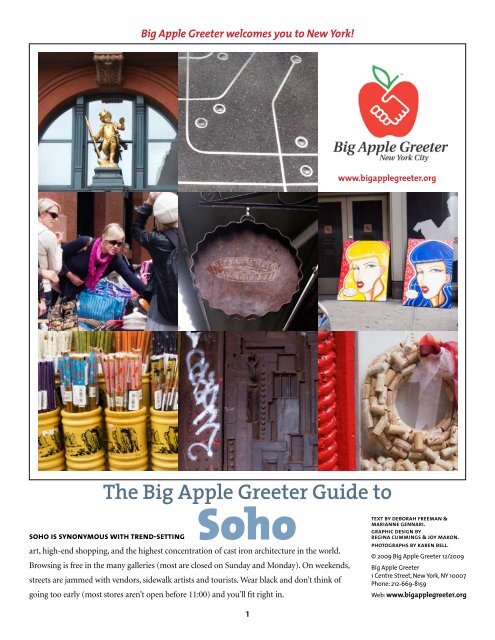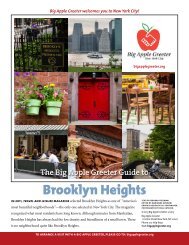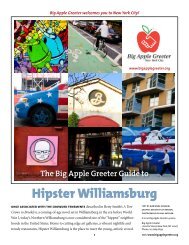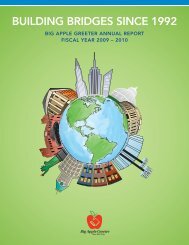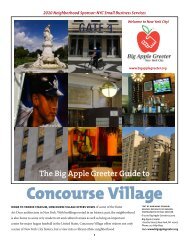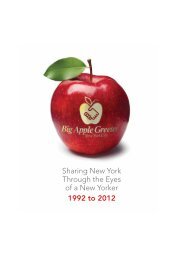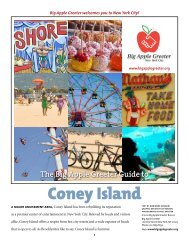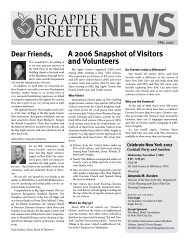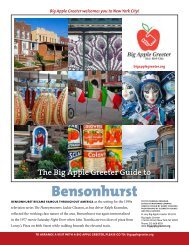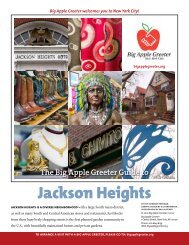Soho - Big Apple Greeter
Soho - Big Apple Greeter
Soho - Big Apple Greeter
You also want an ePaper? Increase the reach of your titles
YUMPU automatically turns print PDFs into web optimized ePapers that Google loves.
<strong>Big</strong> <strong>Apple</strong> <strong>Greeter</strong> welcomes you to New York!www.bigapplegreeter.orgThe <strong>Big</strong> <strong>Apple</strong> <strong>Greeter</strong> Guide to<strong>Soho</strong>art, high-end shopping, and the highest concentration of cast iron architecture in the world.soho is synonymous with trend-settingBrowsing is free in the many galleries (most are closed on Sunday and Monday). On weekends,streets are jammed with vendors, sidewalk artists and tourists. Wear black and don’t think ofgoing too early (most stores aren’t open before 11:00) and you’ll fit right in.1text by deborah freeman &marianne gennari.graphic design byregina cummings & joy makon.photographs by karen bell.© 2009 <strong>Big</strong> <strong>Apple</strong> <strong>Greeter</strong> 12/2009<strong>Big</strong> <strong>Apple</strong> <strong>Greeter</strong>1 Centre Street, New York, NY 10007Phone: 212-669-8159Web: www.bigapplegreeter.org
The <strong>Big</strong> <strong>Apple</strong> <strong>Greeter</strong> Guide to<strong>Soho</strong>balthazarWhere is <strong>Soho</strong>?“<strong>Soho</strong>” is shorthand for “South ofHouston”, a Manhattan neighborhoodthat is indeed south of Houston Street(pronounced “HOW-stun” here), northof Canal Street, and between LafayetteStreet on the east and the Hudson Riveron the west. It is bordered by GreenwichVillage, Little Italy, Tribeca andChinatown.About <strong>Soho</strong>Like many New York Cityneighborhoods, the history of <strong>Soho</strong> ismarked by change. Slaves granted theirfreedom by the Dutch West IndiaCompany in 1644 formed the firstManhattan settlement of free blacks inthe area. At the end of the 18th century,<strong>Soho</strong> became a fashionable residentialneighborhood where upscale storesand businesses began to grow. In theearly 1900s, fashionable businessesmoved uptown and the area filled withsweatshops and factories. The nextmajor change came in the 1960s, whenartists moved to <strong>Soho</strong> in search of largegreeter’s secret: The largestcollection of cast iron buildings inNew York can be found in <strong>Soho</strong>and adjacent Tribeca. Widely usedas a building material beforemodern steel was developed, castiron was valued for its strength,versatility, and reasonable price.Pieces were prefabricated frommolds and builders were able toincorporate elaborate ornamentation. Facades could be quickly erecte, anddamaged pieces could easily be replaced. Ground floors featured large,column-framed windows highlighting vast interiors; while upper floorswere used for offices, storage, and manufacturing. In an age beforeelectricity, cast iron allowed for large windows that admitted more light.studio spaces at low rents. The artistswere followed by galleries and boutiques,and soon by tourists. In the 1980s, realestate prices climbed and, ironically,many artists who reclaimed the area canno longer afford to live in <strong>Soho</strong>. In 1973,the Cast Iron District in <strong>Soho</strong> wasdesignated an historic landmark. Theprotection under law was considered agreat victory in landmark preservation.It’s Easy to Get to <strong>Soho</strong>: by subway: A, C or E trains toCanal Street. C or E trains to SpringStreet. R, N or W trains to Prince Street.B, D, F or V trains to Broadway-Lafayette. 6 train to Lafayette Street.6, J, M, N, Q, R, W or Z trains to CanalStreet. 1 train to Houston or CanalStreets.by bus: Bus lines that service <strong>Soho</strong>include the M1, M5, M6, M20 and M21.bigapplegreeter.org2Things to See and Do in <strong>Soho</strong>The haughwout building at488-492 Broadway atBroome Street is one of themost remarkable examplesof cast iron building. Built in 1857 as an elegantstore, the haughwoutemporium, their mostfamous customer was MaryTodd Lincoln who visitedthe store in 1861 to selectcustom-made china for thesohoWhite House. Other famous clientsincluded the Czar of Russia, and theImam of Muscat who purchasedchandeliers to illuminate the royal harem. The famed building houses theworld’s first passenger elevator. Theelevator was designed by Elisha Otis andis still in place and in working condition.The little singer building at561 Broadway near Prince Street wascompleted in 1904. Famed architectErnest Flagg combined oversizedwindows, red brick, terra cotta panels,wrought iron balconies and cast ironornaments to create one of themost striking buildings in New York.Since 1979, it has been a co-op withboth residential and commercial spaces.graff itigreeter’s secret: The fire escapes on many <strong>Soho</strong>buildings were added after a 1915 New York Cityordinance was instituted in response to fatal loft fireslike the one at the Triangle Shirtwaist Factory in 1911.
The <strong>Big</strong> <strong>Apple</strong> <strong>Greeter</strong> Guide to<strong>Soho</strong>a quintessential cast ironbuilding can be found at 575 Broadwayat Prince Street. Built in 1881 on the siteof the Astor family’s original estate, theremarkable interior was designed byDutch architect Rem Koolhaas. Thegiant wooden wave connecting the twolevels makes it feel less like a store andmore like an art installation about shopping and consumerism. Check out Prada’s changing rooms, built liketwo-waymirrorsso the customer cansee out, but, hopefully, can’t be seen. Greene Street fromBroome toHouston has what is considered the best concentration of cast iron architecture in the neighborhood. The “king ofgreene street” at 72-76 Greene Street was built in 1873 as a warehouse. It is actually two buildings, connectedwith a Corinthian portico stretching thewhole five stories. Its sister building,the “queen of greene street,” at 28-30 Greene Street has Baroque stylecolumns and arches.spring and greene streets the subway map Floating ona new york sidewalk is a 1986 artworkby Francoise Schein, embedded in the sidewalk in front of 110 Greene Streetnear Prince Street. The stylized subwaymaphas north and south reversed. Broome Street is anothertheir website for hoursoutstanding street for viewing cast iron and further informationarchitecture. Don’t miss the cheney at http://www.building at477 Broome Street between nycfiremuseum.org. bigapplegreeter.org 3 soho Greene and Wooster Streets, built in the children’s museum of 1872 as the headquarters for a large silk the arts at 182 Lafayette Streetmanufacturer, and the nearby gunther between Broome and Grand Streets hasbuilding at 469 Broome Street built as interactive exhibits geared towardsa warehouse for a fur dealer in 1871. children. See their website for hours andfurther information atRunning along the length of http://cmany.org/intro.php?pn=home.West Broadway is where you’ll find wellestablishedart galleries, high-end Shoppingstores and lots of small boutiques. Stopbythe elegant soho grand hotel at For something distinctly different,310 West Broadway south of Grand check out pearl river mart at 477Street, to look for celebrities at the bar. Broadway between Grand and BroomeStreets. This vast emporium of ChineseSullivan and Thompson Streets and other Asian goods offers traditionalare charming byways lined with small and modern clothing, housewares,shops and restaurants, some on the gift items, a huge selection of teas andground floors of traditional tenement teapots, as well as toys and dolls. Makebuildings. Look for two beautifully sure to take a look at their musicalpreserved Federal-era houses at instrument and stationery departments.83–85 sullivan street built in 1819,and 116 sullivan street built in 1832. joe’s dairy at 156 Sullivan Street near Houston Street is one of the few the new york city fIre remaining stores from when this was anmuseum at 278 Spring Street near Italian-American enclave. The mozzarellaHudson Street is housed in a restored 1904 cheese, smoked on the premises, isfirehouse. The collection includes fire delicious.engines of variousstyles dating back to greeter’s secret:A mural (faded andpeeling) by artist1790 and all manner of Richard Haas, on theequipment, tools, and corner of Princeand Greene Streets,clothing. There’s also a is painted to matchpermanent Septemberthe cast-iron front.Look for the real11, 2001 memorial. See windows and thepainted cat. sullivan street
The <strong>Big</strong> <strong>Apple</strong> <strong>Greeter</strong> Guide to<strong>Soho</strong> uniqlo at 546 Broadway between Spring and Prince Streets offersJapanese high fashion at reasonable pricesin a 36,000 square foot store. kid robot at 126 Prince Streetbetween Wooster Street and West Broadway is a sleek, ultra-modern storeoffering vinyl figures, both art collectibles and toys, designed by artists, manyfrom Japan. Their t-shirts are popular with hipsters and teens. When It’s Time to Eat housing works used bookcafé at 126 Crosby Streetbetween Lafayette Street and Broadway is a cozy and inviting place toenjoy sandwiches and desserts, and allproceeds go to helping homelessNew Yorkers living with HIV and AIDS.For a schedule of readings and otherevents, check their website atwww.housingworks.org/usedbookcafe. kelley and ping at 127 GreeneStreet near Prince Streetoffers Asian cuisine in a casualloft setting with an open kitchen. blue ribbon at 97 Sullivan Streetbetween Spring and Prince Streets offers an eclectic menu. Thekitchen stays open late, so it’s a favoritehaunt of chefs from other restaurants. lucky strike at 59 Grand Streetbetween Wooster Street andWest Broadway is another latenight hangout, with classic French food.Cultureenjoy the outdoor dining There are numerous galleries along West Broadway, Broadway,Spring and Prince Streets. For galleryofferings and related information, goto http://www.artseensoho.com. Forsomething unique, visit the new yorkearth room at 141 WoosterStreet between Houston andPrince Streets on the 2ndfloor. Learn more about this piece by visiting the websiteat http://www.earthroom.org. Two movie theaters onthe edge of <strong>Soho</strong> showunusual and independentforeign films and feature greatpopcorn. Make sure to visitone or both of the Filmforum at 209 West Houstonkid robotStreet near Varick Street and theangelika Film center at 18 WestHouston Street near Broadway.For featured films and show times,check out the websites athttp://www.filmforum.org and http://angelikafilmcenter.com, respectively.About <strong>Big</strong> <strong>Apple</strong> <strong>Greeter</strong> Founded in 1992, <strong>Big</strong> <strong>Apple</strong> <strong>Greeter</strong>’smission is to enhance New York City’s worldwide image whileenriching the city experience for its visitors. Connecting withbusiness and leisure travelers from all over the US and theworld, <strong>Greeter</strong>s take visitors on informal, unscripted walksthrough one or more neighborhoods in any of the five boroughs,promote tourism throughout the city, and help visitors discoverthe ease of using public transportation. Over 300 volunteer<strong>Greeter</strong>s speak collectively almost 25 languages and enjoy givingtheir time and energy back to their hometown. Since itsfounding, <strong>Big</strong> <strong>Apple</strong> <strong>Greeter</strong>—a free public service—has welcomedover 90,000 visitors and been featured in thousands of newspapers,magazines, and television and radio programs all over theworld, reaching an audience of over one billion potential visitorsto New York City. <strong>Big</strong> <strong>Apple</strong> <strong>Greeter</strong> is proud to partner with NYC& Company, the Metropolitan Transportation Authority and theMake-A-Wish Foundation® of Metro New York.About the Global <strong>Greeter</strong> Network <strong>Big</strong> <strong>Apple</strong><strong>Greeter</strong> is proud to be part of the Global <strong>Greeter</strong>Network, a voluntary association of welcomingprograms around the world, all based on the <strong>Big</strong><strong>Apple</strong> <strong>Greeter</strong> model: free and open to all visitors; offer greeterservices as an individual or very small group experience (nomore than 6 visitors); and are characterized by enthusiastic,local residents who love their home city, love to meet peoplefrom around the world, and volunteer to conduct these visits.The Global <strong>Greeter</strong> Network currently spans seven countrieson four continents and includes the following members: Ciceronesde Buenos Aires in Argentina; Adelaide <strong>Greeter</strong>s and Melbourne<strong>Greeter</strong> Service in Australia; Tap in TO! (Toronto) inCanada; Kent <strong>Greeter</strong>s in Kent, England; Paris <strong>Greeter</strong>, Les<strong>Greeter</strong>s de Nantes, <strong>Greeter</strong>s62 (Pas-de-Calais), Lyon City <strong>Greeter</strong>sand Marseille Provence <strong>Greeter</strong>s in France; Den Haag <strong>Greeter</strong>in the Netherlands; <strong>Big</strong> <strong>Apple</strong> <strong>Greeter</strong> (New York City), Chicago<strong>Greeter</strong>, and Houston <strong>Greeter</strong>s in the United States.You may learn more about <strong>Big</strong> <strong>Apple</strong> <strong>Greeter</strong> andits many services on our website:www.bigapplegreeter.org or by emailing us atinformation@bigapplegreeter.orgbigapplegreeter.org4soho
<strong>Soho</strong>© 2009 <strong>Big</strong> <strong>Apple</strong> <strong>Greeter</strong> 12/2009


